Pillalamarri
The most interesting place to see in Mahabubnagar is the famous banyan tree called Pillalamrri, which is about 4 km from the town. There is a tomb of a Muslim saint under the tree. The tree presents the appearance of a small hillock with green foliage from a distance but on reaching closer, it looks like a large green umbrella under which about thousand people can easily take shelter.It is 700 year old banyan tree and its branches extend over an area of 3 acres.
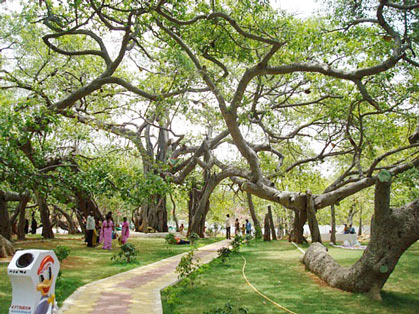
The most interesting place to see in Mahabubnagar is the famous banyan tree called Pillalamrri, which is about 4 km from the town. There is a tomb of a Muslim saint under the tree. The tree presents the appearance of a small hillock with green foliage from a distance but on reaching closer, it looks like a large green umbrella under which about thousand people can easily take shelter.It is 700 year old banyan tree and its branches extend over an area of 3 acres. In Telugu, “Pillalu” means children & “marri” means a banyan tree. There is also an aquarium, a small zoo and an archaeological museum here. There is a boating facility in the premises of Pillalamarri available only during the rainy season.
Pillalamarri Archaelogical Musuem
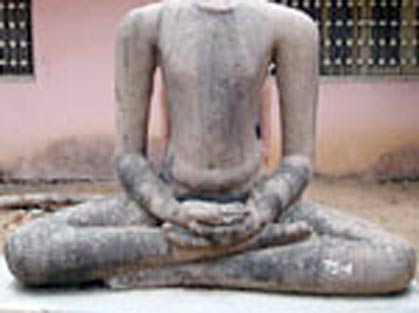
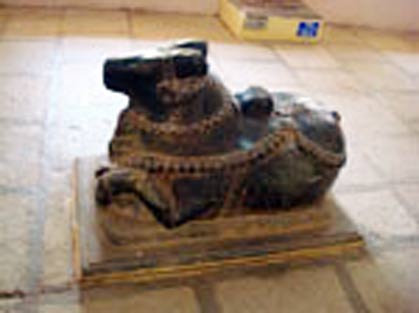
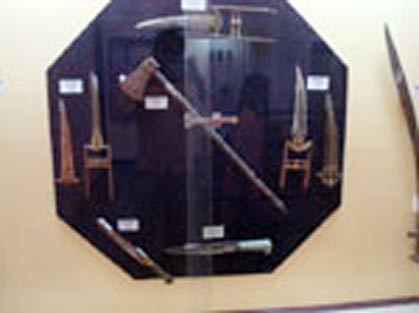
Another Interesting thing near Pillalamarri is District Archaelogical Musuem. It consists of numerous historical idols & articles of ancient people, which represents their culture & civilization. Unfortunately beacause of invasions of various rulers many of those are destroyed. But still there is a lot to see.
Mallelatheertham
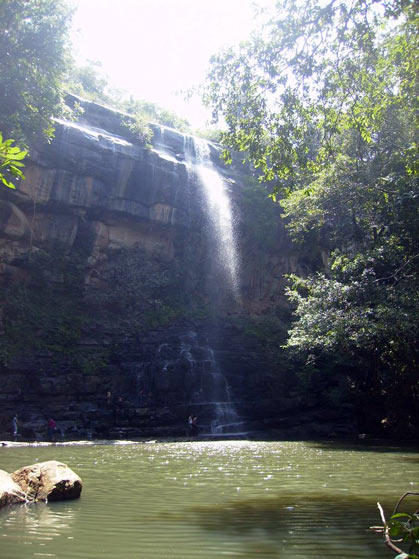
One of the most pleasant place in the Mahabubnagar is Mallelatheertham. It is a beautiful place to visit for the Lovers of Nature. It is a wonderful waterfall located in the Nallamala forest region on the way to Srisailam.
Umamaheshwaram

Umamaheswaram is located at a distance of 150 KM from Hyderabad and close by Achampet in Mahabubnagar District. Umamaheswaram temple is situated on very tall hills of Nallamala forests and dates back to 2nd century A.D. To reach the temple, one has to ride on very steep and dangerous curves of 5 mile length from the bottom of the hill. It is well known as North Entrance to Srisailam (Jyotirlingam). Umamaheswaram temple is in deep Nallamalai forests and located in vast range of Scenic mountains. Umamaheswaram is popular for it’s Misterious papanashanam where you can always find a mug of water what ever you take out from it throughout the year. Nobody could find from where this water is coming. Till today it is the home for innumerous Sadhus. The presiding deities in Umamaheshwaram are Mallikarjuna (Shiva) and Bhramaramba (Devi).
Alampur
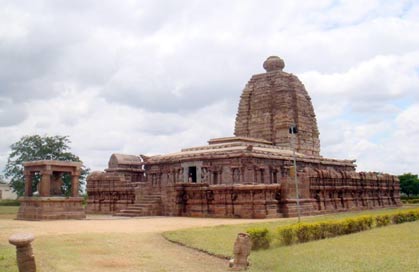
According to the traditions,there are four doorways to srisailam.These entrances are themselves places of pilgrimage.To the east is Tripurantakam.To the south Siddhavattam.To the north is Umamaheshwaram.To the west is Alampur.The most famous temples here are the Nava Bramha temples, A group of nine temples built by Chalukyas.The Nava Bramha temples are situiated with in a miniature.Fortress on the west bank of river Thungabadra.on either side are the temples of goddesses of Kamakshi and Ekamreshwari. These temples are adorned with intricate cavings portraying beautiful sculptures of Gods and Goddesses in various forms and postures.About 1.6 km south of Alampur is Papanasanam,another pilgrim center where there is a cluster of over 20 temples.Alampur is located 130 km from mahabubnagar and 217 km from Hyderabad.
Jetaprolu
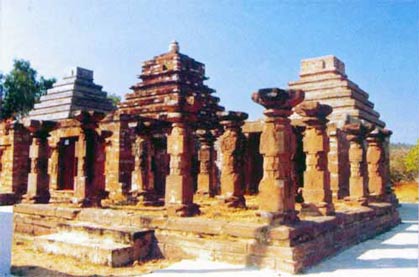
Located 9 km from Kollapur & 158 km from Mahabubnagar, this place is famous for the ancient Agasthyeswara Swamy temple built between the 10 th & 16th century A.D. Festivals like Sivarathri, Kartiha Pournami, Masa Sivarathri and Toli Ekadasi are celebrated with great fervour. This temple was shifted to Jetprole when the Krishna waters threatened to submerge the villages after the construction of the Srisailam dam. Another temple 15 km from Kollapur, is the Madana Gopala Swamy temple built by the Rajas of Jetprole during the 16th century A.D. The pillars, beams and the walls of the temple are richly adorned with beautiful sculptures.
Srirangapur
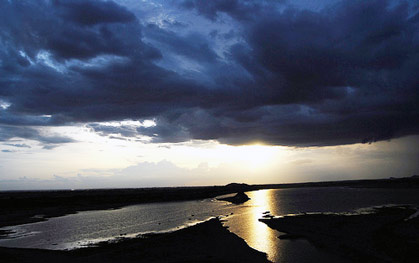
Srirangapur is situated at a distance of 12 km from Wanaparthy, which is 100 km from Mahabubnagar. Here you find a Sri Ranganayakaswamy temple built during the 18th century A.D. According to a legend, king Krishnadeva Raya once visited Srirangam and desired to construct Sri Ranganayakaswamy temple in his kingdom. That night, he dreamt that Sri Ranganayakaswamy told him that He is at some place in his kingdom and an eagle would lead Krishnadeva Raya to that place. Next day, the king followed the eagle and the temple was built on the banks of Ratnapushpakarni lake, between the Kothakota & Karapakala hills.
Somasila

This town is situated 120 km from Mahabubnagar and 10 km from the Kollapuri Someswara Swamy temple. There are 15 temples, all housing Shivalingas where Shivarathri & Karthika Pournami are celebrated with much fervour. The Pushkar Snanam during the Krishna Pushkaram, which occurs once in 12 years, is auspicious. The temple was shifted from old Somasila village to higher land to protect it from being submerged in Krishna waters. With beautiful surroundings, it is also an ideal picnic spot.
Kollapur
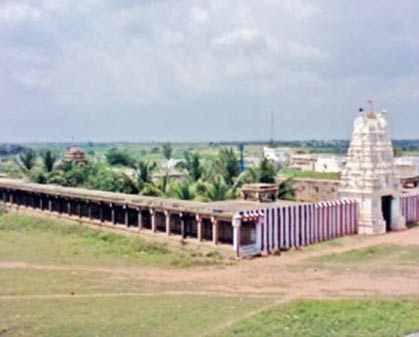
The Madhava Swamy temple at Kollapur was originally built by the 16th century A.D., on the left bank of river Krishna , at Manchalakatta. The architecture of the temple is exceedingly beautiful. All around the temple walls , the beautifully carved sculptures depict the 24 aspects of Vishnu and Dasavathars of Vishnu. Various pillars supporting the mandapa, the Garudalaya, add beauty to the temple complex. Due to the submergence under the Srisailam project reservoir, this temple was shifted and transplanted at Kollapur. This temple is located 180 km from Hyderabad and 110 kms from Kurnool and Mahabubnagar.
Jurala

The Joorala Project (also called the Jurala or Priyadarshini Jurala Project) is situated about 10 km from Kuravapur, Mahabubnagar. It is constructed on the Krishna river. The Kurvapur Kshetra River is merging with water of the Joorala Project. The project was completed in 1995. The Jurala has a full reservoir level of 1045 ft and has a full capacity of 11.94 TMC.
Koilsagar

In Koilsagar Irrigation Project constructed to irrigate an ayacut of 12000Acres, in Mahaboobnagar district, ayacut has not fully developed. It is now proposed to lift water from fore shore of Jurala Project in two stages to a total lift of 120m with 4 Nos. of Pumps of 10,000 HPreach and to fill up the Koilsagar Project to stabilize the ayacut of 12000 Acres including a gap ayacut of 7500 Acres and to irrigate an additional 38250 Acres bringing the total to 50,250 Acres under the project at a quoted value of Rs.360.20 Crores.
Gadwal

This is situated between the rivers Tungabhadra and Krishna over an area of about 800 sq.miles. After the fall of the Warangal Andhra dynasty in the 14th century, Gadwal transferred its allegiance to the new Bahmani kingdom. According to the family history, Pedda Veera Reddy, Peddanna Bhupaludu, Sarga Reddy, Veera Reddy and Kumara Veera Reddy ruled Gadwal between 1553 and 1704. During the reign of Nizam Ali Khan Asaf Jah II, the Martha’s gained power in certain parts of the Deccan and started collecting ‘chouth’ or 25% of the revenue known, as ‘Do-Amli’ are the double government of the Nizam. Raja Sitaram Bhupal died in 1840 and was succeeded by his adopted son, Raja Sitaram Bhupal II. Nizam VII bestowed on him the title of “Maharaja” and he died in 1924 and was survived by his widow and two daughters.
Gadwal – Chennakeshwaralayam

There is a famous historical Temple called Chennakeshwaralayam where Lord Venkateshwara was prayed by ancient rulers of gadwal & still a great carnival is celebrated every year. It was built by the Rulers of Gadwal sansthan & is situated within the Gadwal Fort as a great historical evidence.
Kollapur

Kollapur smasthan with a large area spanning most of the nallamala forest area on the banks of river Krishna. There are traces of architectural treasures from 2nd century B.C. in this samasthan. Still you can see hundreds of ancient temples, which were built before 1500 years ago. Kollapur Samasthan played a considerable role in Nizam’s era.
Kollapur – Madhana Gopala Swamy Temple

The Madhava Swamy temple at Kollapur was originally built by the 16th century A.D., on the left bank of river Krishna , at Manchalakatta. The architecture of the temple is exceedingly beautiful. All around the temple walls , the beautifully carved sculptures depict the 24 aspects of Vishnu and Dasavathars of Vishnu. Various pillars supporting the mandapa, the Garudalaya, add beauty to the temple complex. Due to the submergence under the Srisailam project reservoir, this temple was shifted and transplanted at Kollapur. This temple is located 180 km from Hyderabad and 110 kms from Kurnool and Mahabubnagar.
Wanaparthy

This is situated in Mahboobnagar district with an area of about 640 sq.miles. The Rajas of the Samasthans were closely associated with the QtubShahi kings. The early Rajas of Wanaparthi kept on army of 2000 infantry and 2000 cavalry. On 17th March 1843, the title of “Balwant” was conferred on Raja Rameshwar Rao as a mark of honour by Sikander Jah. For administrative purposes the Samasthan was divided into two taluqas namely “sugar” and “Kesampet” under to Tahsildars. The “Maharaja” died on 22nd November 1922. He was survived by two sons, Krishna Dev Rao and Ram Dev Rao. Recently this family represented in the Indian government after Independence.
కామెంట్లు లేవు:
కామెంట్ను పోస్ట్ చేయండి